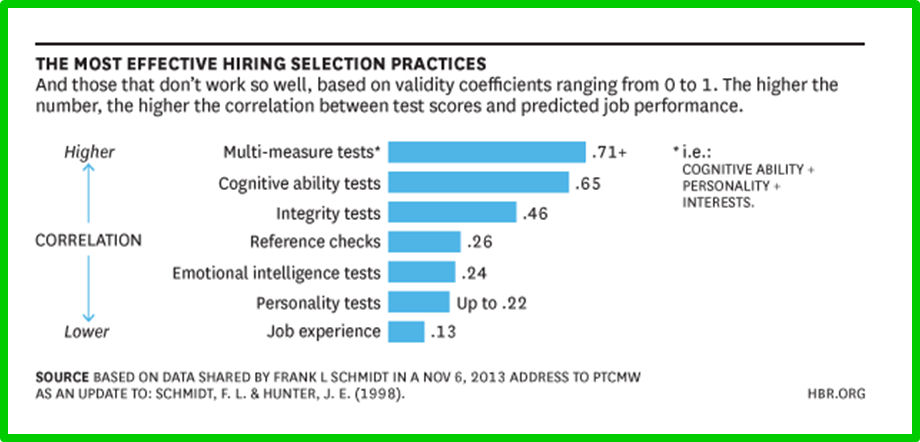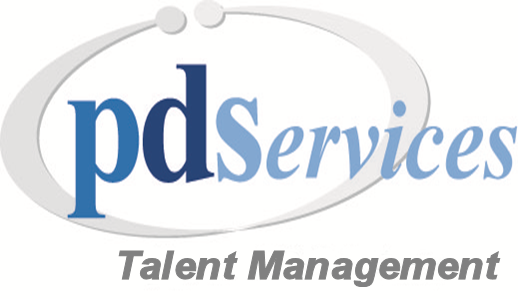Hiring Based on Gut Feel and Investing in Bitcoin
/in Assessments, General, Whitepaper /by Sue Devendorf
Hiring based on gut feel and investing in Bitcoin are both risky ventures depending on the research you have done and the data you have to support your decision!
I am interested by the idea of Bitcoin, but I still don’t really understand it. Its value seems to be based on the perception of its owners and a supply and demand concept. By nature I am very methodical, detailed, and data driven and as yet I am not convinced to invest.
Whether they realize it or not, many employers are hiring based on gut feel. Most employers rely on 2 major pieces of information. A resume (quite possibly exaggerated), and an interview where you generally meet a candidate face to face and get an overall “gut feel” as to whether or not you want to hire this individual.
The Harvard Business Review reported correlations between data available in the hiring process and job performance as indicated below. NOTE that a resume and interview don’t even make the list!

To minimize your risk, you can support your decision with scientific data. You can use assessments to measure how a candidate might fit your particular job. We call this Job Fit or Job Match. Notice in the list above that job experience and personality tests are on the low end of the scale and cognitive and multi-measure tests rate the highest in correlation to predicted job performance.
Our next generation suite of assessments are multi-measure and provide cognitive (or reasoning ability), honesty and integrity measures, personality or behavioral traits, and occupational interests. They generally pay for themselves by saving you the cost of one bad hire. See my article titled How $30 Can Save You $5000 and Help Reduce Turnover
How $30 Can Save You $5000 and Reduce Employee Turnover
/in Assessments, General /by Sue Devendorf
A simple assessment during the pre-hire phase of your process can literally save you thousands of dollars and reduce employee turnover.
Did you know that over 50% of companies / organizations are using assessments and over 94% of top performing organizations use assessments? (as reported by Aberdeen)
Are All Assessments Valid for Hiring?
There are many assessments out there and too many to compare in this article. BUT you should be aware that many popular assessments should not be used in the hiring process. Many assessments measure what we call Adaptive Behaviors where a candidate rates themselves in different scenarios. These behaviors are learned and can change.
Current psychometric technology measures Core Behaviors (or behaviors that are inherent in the individual and do not change). This will give you a more accurate picture of how someone will perform.
Many assessments only measure personality traits. We recommend measuring cognitive or reasoning which tell us how quickly a candidate learns. This can be extremely valuable for onboarding and training and indicate if someone is a good fit for a job.
Honesty and Integrity is also a measure that is so important these days.
It is also advantageous to measure a candidate’s interests. Will they like the job?
Make sure your assessment is valid for hiring and that it has a validation study to show that it does what it is supposed to do.
The Harvard Business Review published a study that shows that an assessment that uses all of the measures mentioned above ( in one assessment ) has the highest correllation to job performance of any information available in the hiring process. (NOTE: A resume doesn’t even make the list!) Finding the right person for the right job can reduce turnover.
We offer a suite of assessments which are amazingly priced for entry-level / hourly, mid-level, and upper-level jobs. Compare candidates to a benchmark.
Find the right person for the right job and reduce employee turnover with our easy to use and affordable assessments.
So How Exactly Can $30 Save You $5000?
Let’s take a look at How to Estimate the Cost of Turnover.
Research by SHRM and by the American Center for Progress show that the average cost of Turnover is about 20% of an employee’s annual wage. This is a very conservative figure but this is what I will use for comparison.
Depending on the job, these percentages will vary and there are studies that quote turnover costs as high as 50 – 60%. Also, the type of job or salary range of a job can reduce or increase the effective cost of turnover. Workers making less than $30,000 a year may be 16.1 – 20% and manager and executive levels would be considerably higher.
Think about all of the peripheral costs associated with losing an employee such as:
Cost of Temp workers and lost productivity while they learn the job
Reduced morale and lost productivity from co-workers and managers covering for the lost position
Recruiting Costs which could include an outside recruiter, resume screening, background checks, reference checks, interviews, applicant screening, assessments, physicals, drug tests, travel expenses
Onboarding and Training Costs for the new employee which may include certifications and licenses, uniforms, training to learn company procedures and computer systems, etc.
The time it takes for a new employee to become productive
If you are not using assessments, or if you are currently using assessments and would like to compare, please visit our site at PDServices.com to learn more about our next generation assessments.
Call us today at 740 397-4928 to learn how easy and inexpensive it is to get started. You’ll be glad you did!
Thus the average cost of losing an employee who makes $30,000 a year is $6000 assuming a 20% cost of turnover and $4830 assuming a 16.1% cost of turnover… And that’s how $30 can save you $5000 or more and help reduce employee turnover!
Elder Care Front Line Employees Case Study
/in Assessments, General /by Phil Devendorf
Organizations working with seniors are experiencing high turnover in elder care front line positions. This is frustrating because it is difficult to attract candidates in the first place. PDServices was invited to participate in a case study to help Elder Care organizations improve the quality of new hires and reduce turnover.
Purpose
The purpose of the study was to validate the use and value of entry level assessments for hiring front line employees in elder care.
Approach
Our approach was to create a benchmark of characteristics for high performing, long term employees. Assessments of high and low performing front line employees were completed across multiple elder care organizations. Employees were grouped by job type and performance level for analysis. The goal was to identify where high performers score in various assessment categories. This provides a roadmap or benchmark of desired scores (High, Med, Low or 1 – 18), for each assessment score.
Results
The elder care study validated the benefit in using this assessment for front line hiring and onboarding. The assessment differentiates high performers in different elder care job types and gives the hiring organization a great deal of objective information about a candidate at a remarkably low cost. Using the benchmarks should result in reduced turnover and increased productivity.
Assessment Scales
Can Do
Do they have the learning and reasoning ability to do the job?
Positive Outlook
Optimism toward people and outcomes
People Orientation
Preference in working with and socializing with people
Productivity
Stamina, endurance, and a capacity for a fast pace
Conscientiousness
To work and treat others with honesty and integrity, and to adhere to rules and policies
High Performer Ranges
- Position
- Care Givers
- Front Line
- Can Do
- High
- Med / High
- Outlook
- 11+
- 9+
- People
- 8 – 15
- 6 – 12
- Conscientiousness
- Med / High
- Med / High
Top performing Care Givers have high reasoning ability , (Can Do), as their jobs require problem solving and decision making. High Positive Outlook correlates to being able to overcome setbacks, important for Care Givers. Care Givers are mid range on People Orientation. This may seem surprising and although we want them to be pleasant, we also want them to be able to manage their time and not get caught up in small talk at the expense of their duties. Productivity is high but not so high as to lose attention to detail.
Front Line includes maintenance, housekeeping and food service. The jobs here vary a bit and the high performing scores reflect that. Maintenance is generally a problem solver so high Can Do is the best fit. Housekeeping and food service are more repetitive so medium Can Do fits. Mid to high Positive Outlook, People Orientation and Productivity are best fits for these Front Line jobs.
High Conscientiousness is a critical measure for any Care Giver or Front Line employee. These employees often have access to residents’ quarters and build trusting relationships with residents. Honesty and integrity, measured by Conscientiousness, is crucial.
Recommendation
The elder care front line study results show a high correlation between assessment scores and high performers. Using a candidate’s fit to the score ranges above will be a good predictor of fit to the job. Better job fit leads to improved retention and productivity.
It is also important to note the value of this information in on-boarding and managing new hires. If you choose to hire a candidate who isn’t a good fit, their assessment results can help target training areas. By working with the new employee to adapt to any shortcomings, you improve your chance of retaining that employee.
Given the low cost and convenience of these assessments, there is significant value in incorporating these assessments in the elder care hiring process to improve retention and productivity.
Learn more about this assessment for entry level and hourly employees.
Contact PDServices today to see how easy and affordable it is.
Contact PDServices at 740-326-4494 or info@PDServices.com
Select Entry Level Hires to Fit Your Job
/in Assessments, General /by Phil Devendorf
Your entry level hires today are key to the future of your company.
“97% of employers cite that entry-level positions are important to their organizations” (from The State of Entry-Level Employment, March 2017, Rockefeller Foundation)
Most of us see the truth in the statement above. In many industries, our entry-level or hourly employees make our product, deliver our service and/or interface with our customers.
Entry level employees are directly responsible for:
Product / Service Quality
Product / Service Cost
Customer Satisfaction
The same study confirms that a majority of organizations are still relying on outdated hiring practices. These practices often lead to hiring based on first impressions and selecting candidates based on irrelevant factors. What do we need to know? Here are three areas that matter when evaluating entry level hires:
Can They Do the Job?
We are good at evaluating physical abilities like lifting and climbing. However, studies show that fitting a candidate’s cognitive abilities with the job, (ability to learn and reasoning ability), is the biggest factor in productivity and retention. Gaining insight into candidate’s cognitive abilities is critical to making good entry level hires. Lower cognitive abilities are a fit for repetitive jobs while higher cognitive abilities are needed for jobs that require continual learning, decision making and adaptation. Conversely, a candidate with high cognitive skills will be bored in a repetitive job and is likely to quit.
Will They Do the Job?
This is where a candidate’s personality traits come in. For example, understanding if a candidate is people oriented is key if the job requires customer contact. On the other hand, high sociability is a negative if the job requires working alone. Patience and focus might influence job fit for employees making a product or delivering service.
How Will They Approach the Job?
Conscientiousness is important in any entry level position. Conscientiousness tells us the candidate’s tendency to work with honesty and integrity and to follow the rules of the organization. If your employees enter customers homes or have access to sensitive information, conscientiousness is particularly important.
How Do We Improve Selection of Our Entry Level Hires?
Assessment tools targeted for entry level hires can give us good, objective measures of a candidate’s cognitive ability, personality traits and conscientiousness. They help us to evaluate a candidate’s fit with the job. These tools can be surprisingly inexpensive (~$30 per candidate) and are easy to administer. See our article title How $30 Can Save You $5000 and learn about the cost of Turnover. Visit PDServices for more information on entry level assessments. Call 740-326-4494 or email info@PDServices.com to request a complimentary entry level assessment.
Contact PDServices today to schedule a demo and learn how we can help your organization!
Make Informed Hiring Decisions
/in Assessments, General /by Phil Devendorf
At a recent business conference, a number of people told me that they are struggling to hire qualified candidates who perform at or above expectations. Turnover is also a problem. Research shows many CEOs and other executives believe that their competitive advantage and even survival is based on the quality of their employees. That means you must excel in hiring and retaining top performing employees. And how can you do that? By making informed hiring decisions.
One hiring challenge has been “instinctive” hiring, where the interviewer/ hiring manager makes a gut decision based on instinct. A lack of reliable, objective information forces a decision that is not data driven. This gut feel hiring has an average success rate of 25%, meaning that 75% of the time you will end up with an employee who does not meet your expectations in some fashion.
Traditional information sources such as applications, resumes, and interviews all provide candidate information with questionable validity. How can we make good hiring decisions with poor information?
Objective Information
One popular approach to making informed hiring decisions is to gather objective candidate information by using candidate assessments. This has become a $400 million industry and is growing by 8 to 10% annually. Bersin (a Deloitte company) estimates that 90% of top performing organizations use assessments in some fashion. A Harvard Business Review study found that a candidate’s reasoning ability, personality traits and interests are key indicators of success and retention in a job. Psychometric research supports the HBR findings. This candidate information is not easily gathered through traditional interviews, applications, etc. Assessments give reliable information on these candidate characteristics. As an example, high reasoning ability means that the candidate can learn quickly and process large amounts of information effectively. This characteristic is critical to success in information intensive jobs. On the other hand, if the job is repetitive, an employee with high reasoning ability will get bored and disengage, leading to poor performance and/or turnover. Consider a personality characteristic like People Contact. This is the tendency to be outgoing, people oriented, and to participate with others. A high score in people contact is important to performance in a customer service related job but could be detrimental to an engineer or programmer who needs to work independently for long periods of time. Our “Workforce” assessment measures Conscientiousness, a measure of one’s willingness to work with honesty and integrity, and to follow rules. Are these characteristics important to your entry level hiring? Do you have any other reliable way to evaluate this candidate characteristic?
Job Fit
Gathering objective information on a candidate’s reasoning ability, behavioral traits and interests is only helpful if you know what you are looking for. Studies show that employees who are well matched to their jobs are 2.5 times more productive. This means you should first define a benchmark of characteristics that make an employee successful in the job. Once you have a benchmark, you can compare a candidate’s assessment results to gain insight into job fit. This allows you to truly make an informed hiring decision. There are a few ways to create a benchmark and it is much easier that most people think. The most objective approach is to assess top performing employees in a particular job in your organization. Use their results to form the benchmark for that job. You will see top performers cluster together in important characteristics for success. Often, you won’t have the luxury of having enough top performing employees in a job to use as benchmarking models. Fortunately, there are preliminary benchmarks available for most jobs. These can be used as a starting point and adjusted as needed for your specific job responsibilities and organizational culture.
Assessing Candidates
Once you have a benchmark of success characteristics, you are ready to assess candidates. First, decide when to assess. Some organizations assess early in the process in order to avoid wasting time on candidates who clearly don’t fit. Others choose to wait until later in the process to control the money spent on assessments. Whatever you do, just be consistent with all candidates within a given hiring requisition. Most modern assessments can be administered via the internet. This streamlines the process and provides immediate results. Choose an assessment that is scored immediately and provides reports suitable for a typical hiring manager. Finally, don’t throw this information away once you make a hire. The information from the assessment can be very helpful during your new employee’s on-boarding and beyond to help understand their strengths, weaknesses and motivations leading to longer term retention.
Compare your candidate’s results to your benchmark. Some assessments do this for you as part of the report and even suggest interview questions. If not, make sure you consider your benchmark as you review the report. Note that the assessment should not dictate a hiring decision, but will provide objective data to assist in your decision.
PDServices has been helping organizations make informed hiring and management decisions by implementing assessments for over 20 years. Learn more about our employee talent assessments here . Contact us at info@PDServices.com or call 740-326-4494 to discuss how assessments can be valuable for your organization.
Merit Compensation
/in General /by Sue DevendorfWhat is Merit Compensation and How Do I Implement It?

Merit Compensation is a process that allows you to reward employees based on performance, job and pay range. The object is to distribute your compensation budget fairly while not over compensating or under compensating for a particular job.
PDServices offers a system to help you manage merit compensation with large company function but at an affordable price for small to mid-sized organizations.
Paying for Performance
Paying for performance has long been the ideal in managing an organization’s compensation. The objectives tend to also include things like fairness, maximizing the impact of the salary spending, maintaining competitive salaries without overpaying.
Managing Merit Compensation
Managing merit compensation can be complicated and time consuming without following a basic structure and automating wherever possible. The process is:
Establish a salary range for each position or pay grade
Establish a merit matrix defining increases based on performance and where the employee falls within the salary range.
Determine your compensation budget
Calculate employee compa-ratio (where they fall relative to the mid-point of the salary range)
Calculate suggested increases based on performance, current pay, and budget
Provide suggested increases to managers for review and approval
Make any adjustments to the suggested increases, get approvals, and submit to payroll
A few of these process steps warrant further discussion and tips.
Establishing Salary Ranges:
There are a number of approaches to establishing your salary ranges. The appropriate choice depends on the time and resources you have available and the size and complexity of your organization. Approaches include:
Evaluate your current salaries for that position
Research salaries for similar positions from your recruiters, industry organization, web-sites, etc.
Purchase salary surveys or find them on the internet (i.e. http://online.onetcenter.org/)
Establishing a Merit Matrix:
Start by defining the x-axis as your performance rating scale (for example 1 through 5). The y-axis then is a measure of where the employee falls within their salary range. A common measure is the compa-ratio calculation with a compa-ratio of 1 meaning the employee falls at the mid-point of the salary range. Another measure can be where the employee falls within a quartile of the salary range.
The values of the cells in the matrix indicate what percentage increase the employee receives based on his/her performance and current pay. The cell values must incorporate the percentage increase in overall salary budget.
The intent of this matrix is that the highest increases are paid to high performers that currently have a salary that is low in range. In other words, they are underpaid for their contribution. A high percentage increase should move them up in their range. Conversely, a highly paid employee in range who is not performing well may not receive any increase at all.
Establishing the matrix may be the most difficult part of creating a fair and effective program. You may find it helpful to use a system or consultant that provides some “what if” analysis for creating the matrix. Standard matrices are available as a starting point.
Establishing a Salary Budget:
While your CFO and others may dictate this budget line item, consideration should be given to where the organization falls, on average, compared to your salary ranges. If you have established your ranges based on local and/or industry norms, you may need a larger budget in order to stay competitive when you are below the mid-point of your range on an overall basis.
Salary ranges and budgets generally are adjusted for cost of living/inflation.
Calculating Suggested Increases:
At this point, you have all of the raw material to calculate suggested salary increases. This becomes a matter of finding each employee’s performance rating and where they fall in range. Find the appropriate cell on the merit matrix and determine the suggested percentage of salary increase.
An Automated Approach:
You will find that an automated compensation system (such as PDS’s Merit Compensation Tool) can simplify this process and save you a great deal of time. A good compensation tool can assist in defining your salary ranges, merit matrix, and compa-ratios. The system should have the ability to import employee data from an HRMS, Performance Management and/or Payroll system to provide required employee and salary information if available electronically. The system can then calculate suggested increases and create reports or spreadsheets to be reviewed by managers. The system can also assist by providing reports and graphs that help manage and analyze the compensation process and results.
Contact Us
4015 Executive Park Drive, Suite 100C
Cincinnati, OH 45241
Phone: 740-326-4494
Email: info@pdservices.com
© 2024 PDServices | All Rights Reserved

